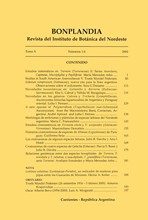TAXONOMIA DEL GENERO HELICTERES (STERCULIACEAE). REVISIÓN DE LAS ESPECIES AMERICANAS
DOI:
https://doi.org/10.30972/bon.111-43944Palabras clave:
taxonomy, Sterculiaceae, HelicteresResumen
Helicteres is a genus of Stercu/iaceae in which 60 species are accepted. It is divided into seven sections: four are monospecific and include Heicteres of the old world and Helicteres, Stegogamos and Polyandria of the new world (the last two described here ror the first time); the other three sections are redefined, Orthothecium with 17 species, Sacarolha with 18 species, and Orthocarpaea with 21 extra-american species. A comparison of the infrageneric systems of six authors is given in Table 1. In the present revision the 38 American species are taxonomically revised. The area of the genus, which includes the tropics except Africa, the areas of the sections, and the distributions of the American species are represented in 11 maps. The American monospecific sections Stegogamos and Polyandria live in the W of Mexico, and A/icteres is found on the atlantic coasts of Colombia and Venezuela. Within the total areas of the sections Orthothecium and Sacarolha, regions are delimited with high species concentration, which overlap in a great measure in central eastern Brazil. Within the section Orthothecium, which extends from the S of Mexico to the NW of Argentina and Paraguay, where only H. Lhotzkyana is found, a secondary insular area is circumscribed with four caribbean species. A key is provided for the sections as well as keys and descriptions for the 38 accepted American species. Among them, nine are new to science: H. /aciniosa, H. rufipila, H. Andersonii and H. biflexa belonging to section Orthothecium, and H. Pintonis, H. Krapovickasii, H. Cidii, H. Vallsii and H. denticulenta of section Sacarolha. With the aim of understanding the structure of Heicteres, a bibliographic revision of the species of the old world was carried out. In the Appendix of this work descriptions of both Asiatic sections are presented, and their type species are described. A provisional synopsis of the 21 species of section Orthocarpaea is presented, with the most common synonyms cited in the literature. It must be noted that the species of this section, especially those of Australia, are in great need of revision, and that the literature analysis and listing provided do not pretend to constitute such a revision. In the chapter on morphology, the types of inflorescences are interpreted and illustrated. In relation to the flower, the variability of each whorl is analyzed; in particular the symmetry and morphology of the corolla are taken into account to circumscribe sections and species. On the basis of the relative position of the different parts, two types of flowers are distinguished. In the first type, exclusive of the section Sacarolha, the pedicel, the androgynophore and the axis of the ovary are aligned, so that the flowers are straight and pseudactinomorphic. In the second type, the flowers show an angle between the pedicel and the androgynophore, or between the androgynophore and the axis of the ovary, or in both places, so that the flowers are geniculated and pseudozygomorphic.
Changes in the morphology of the claw are emphasized in the two superior petals or the three inferior ones, and in clockwise or anti-clockwise contorted flowers. In the illustration of each species the petal claws are represented, keeping the sequence they have within the flower. This shows the degree of differentiation between the superior and inferior petals. The significance of length relationships between claw and petal blade, and between corolla and calyx, is highlighted. Attention is called also to the spirally twisted fruits, for which the genus is named, the equally frequent straight fruits, and the intermediate forms. According to the published chromosome counts, which are summarized, the genus seems to be uniformly 2n=18. The data about two Asian species with a different number should be checked. Nine pollen types are defined for the genus and the possible evolutionary lines are interpreted, as well as their relations with the sections (Pire & Cristóbal, 2001). Infra- and inter-generic relationships are discussed, but questions about the origin and evolutionary history of the genus are unresolved.
Concerning the differences between Helicteres and related genera, it is pointed out that the exclusive characters of Helicteres, such as the presence of nectaries on the peduncles, geniculate androgynophore, short petal c1aw (4-8 times shorter than the calyx), and spirally twisted fruits, are not common to all species of the genus. On the contrary, characters that are present in all the species, such as perfect flowers, connate sepals, anthers with divergent thecae, lignous syncarpous fruits made of five carpels, and apterous seeds, can be found in neighboring genera. For these reasons it is understood that a species belongs to Helicteres when one or more of the exclusive characters listed above are present with one or more of the general characters, even though they are present in other genera. AH the American species are iHustrated with the sole exception of H. cuneata, known only from a phototype, as well as the type species of the extra-american sections, making a total of 41 figures.
Descargas
Descargas
Publicado
Cómo citar
Número
Sección
Licencia
Declaration of Adhesion to Open Access
- All contents of Bonplandia journal are available online, open to all and for free, before they are printed.
Copyright Notice
- Bonplandia magazine allows authors to retain their copyright without restrictions.
- The journal is under a Creative Commons Attribution 4.0 International license.















.jpg)


